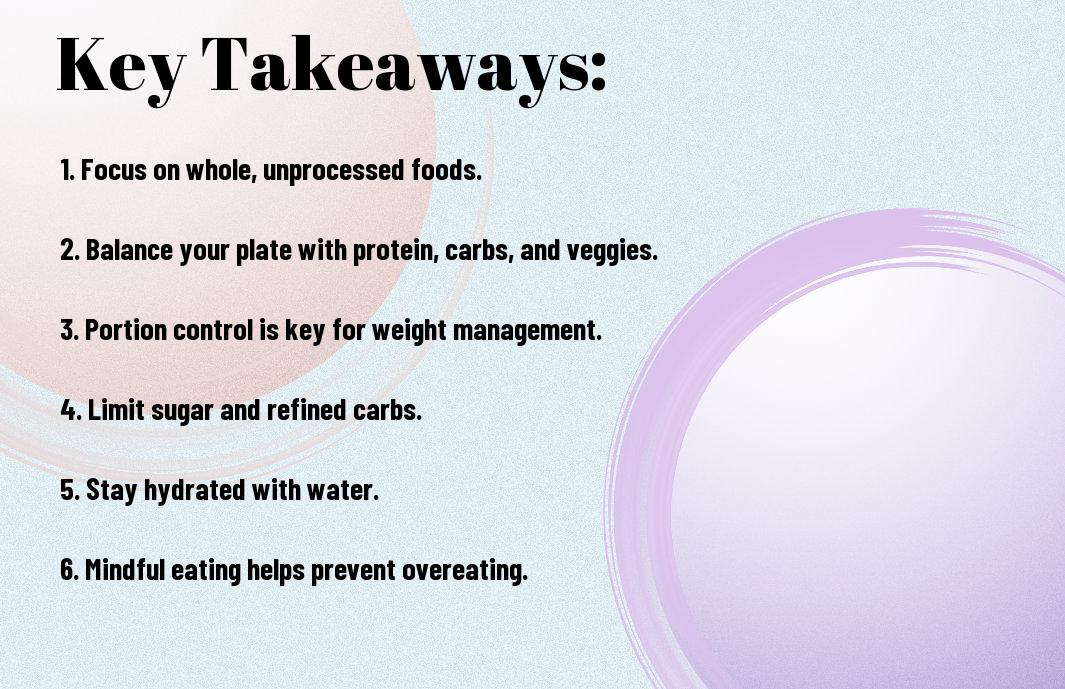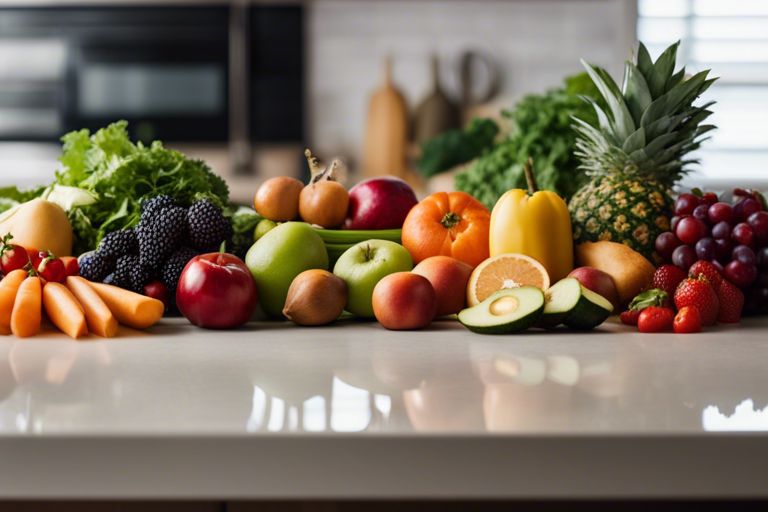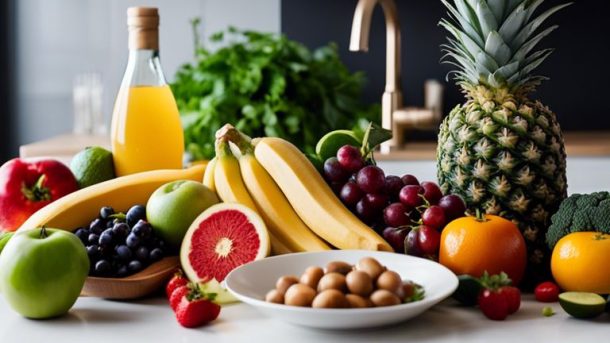With so much conflicting information about nutrition out there, it can be overwhelming to know what to eat to stay healthy. In this blog post, we will provide you with practical tips and advice on how to make healthier food choices and develop sustainable eating habits. By following these simple guidelines, you can take charge of your health and well-being through the power of nourishing foods.
Key Takeaways:
- Balance your meals: Include a variety of fruits, vegetables, lean proteins, whole grains, and healthy fats in your diet to ensure you are getting all the imperative nutrients.
- Watch portion sizes: Be mindful of portion sizes to avoid overeating and to maintain a healthy weight. Use smaller plates, bowls, and utensils to help control portion sizes.
- Stay hydrated: Drink plenty of water throughout the day to stay hydrated and help your body function properly. Limit sugary drinks and opt for water, herbal teas, or infused water instead.
Setting Healthy Eating Goals
Identifying Your Motivations
Eating healthy starts with identifying your motivations. What drives you to want to eat better? Is it to have more energy, improve your overall health, or simply to feel better about yourself? By understanding the reasons behind your desire to eat healthier, you can set more specific and achievable goals for yourself.
Assessing Your Current Diet
An crucial step in setting healthy eating goals is assessing your current diet. Take a close look at what you eat on a daily basis. Are you consuming enough fruits and vegetables? How much processed foods and sugary drinks are part of your regular intake? Assessing your current diet can help you pinpoint areas that need improvement and guide you in making necessary changes for a healthier lifestyle.


Building a Balanced Plate
Clearly, maintaining a balanced plate is crucial for your overall health. To ensure you are getting the right nutrients, check out this Healthy eating basics | Heart and Stroke Foundation guide.
The Importance of Whole Foods
Foods that are minimally processed, such as fruits, vegetables, whole grains, lean proteins, and healthy fats, are necessary for your well-being. These whole foods are rich in vitamins, minerals, and antioxidants that support your body in functioning at its best. Incorporating these items into your diet can help reduce the risk of chronic diseases and improve your overall health.
Incorporating Variety and Color
For a truly balanced plate, aim to include a variety of colorful fruits and vegetables in your meals. Different colored produce contain different types of nutrients, so by eating a rainbow of fruits and veggies, you ensure you’re getting a wide array of vitamins and minerals necessary for your health. Additionally, the different flavors and textures will make your meals more interesting and enjoyable.
Portion Control and Mindful Eating
Control over portion sizes and adopting mindful eating habits are key components of maintaining a balanced plate. It’s necessary to listen to your body’s hunger and fullness cues, as well as to be aware of the portion sizes you are consuming. By slowing down during meals, savoring each bite, and paying attention to your body’s signals, you can prevent overeating and better regulate your food intake.
It’s all about nourishing your body with the right foods in the right amounts to promote optimal health and well-being. Bear in mind, building a balanced plate is not just about what you eat but also how you eat it. By being mindful of your food choices and eating habits, you can cultivate a healthier relationship with food and set yourself up for long-term wellness.

Navigating Nutrition Labels
Food packaging can be overwhelming with all the information displayed. After a brief scan, you might toss it in your cart without really understanding what’s inside. However, taking the time to decode food labels can help you make healthier choices for you and your family.
Decoding Food Labels
Food labels are a great tool for understanding what you are putting into your body. They provide valuable information on serving sizes, calories, nutrients, and ingredients. Pay attention to the serving size, as many packages contain more than one serving. This can impact the total calories, fats, and sugars you consume. Look for high amounts of added sugars, unhealthy fats, and artificial ingredients – these can lead to health issues when consumed in excess. Recall, the ingredients list is organized by quantity, so the first few ingredients are the most prevalent in the product.
Watching Out for Hidden Ingredients
One crucial aspect of reading food labels is keeping an eye out for hidden ingredients. Many processed foods contain additives like artificial colors, flavors, and preservatives that may pose health risks when consumed frequently. These ingredients can be disguised under names that are hard to pronounce or unfamiliar to most people. By choosing whole, minimally processed foods, you can avoid these hidden ingredients and opt for healthier alternatives.
One effective way to spot hidden ingredients is to look for terms like “hydrogenated oils,” “high-fructose corn syrup,” or “artificial flavors” in the ingredients list. These are red flags indicating the presence of potentially harmful additives. Recall, the fewer ingredients listed, the better. Opt for products with recognizable, whole-food ingredients to ensure you are making the best choices for your health.
Making Sense of Nutrient Claims
Decoding nutrient claims on food packaging can be tricky, as manufacturers often use terms like “low-fat” or “all-natural” to attract consumers. An important tip is to focus on the actual nutrient content rather than just the claim on the front of the package. For example, a product labeled “low-fat” may be high in sugar or sodium to compensate for flavor. Be sure to read the nutrition label to get the full picture of what you are consuming.
An crucial point to remember when evaluating nutrient claims is to consider your overall diet. Just because a product claims to be “high in fiber” or “vitamin-rich” doesn’t mean it’s the healthiest choice. Balance is key, so aim for a varied diet with a mix of nutrients from different food sources to ensure you are meeting your nutritional needs.
Hidden
Hidden ingredients in food products can sometimes be tricky to identify, as manufacturers may use terms that aren’t immediately recognizable. Common hidden ingredients include artificial sweeteners, MSG, and food colorings that may have negative effects on your health. Be vigilant when reading labels and opt for products with simple, transparent ingredient lists to avoid these hidden additives. Recall, your health is worth taking the time to decipher these labels for better-informed choices.
Stocking a Healthy Kitchen
Pantry Staples for Healthy Cooking
For an efficiently stocked and healthy kitchen, it’s important to have a range of pantry staples on hand. Items like whole grains (brown rice, quinoa), legumes (beans, lentils), nuts, seeds, and a variety of herbs and spices can form the foundation of countless nutritious meals. These ingredients are not only versatile but also provide important nutrients like fiber, protein, and healthy fats.
Fresh Produce: What to Buy and How to Store
An important aspect of maintaining a healthy kitchen is having a selection of fresh produce. Fruits and vegetables should make up a significant portion of your diet, providing important vitamins, minerals, and antioxidants. When choosing produce, opt for a variety of colorful options to ensure you’re getting a diverse range of nutrients. Store your produce properly – some items like bananas and tomatoes should be kept at room temperature, while others like leafy greens and berries are best stored in the fridge to prolong freshness.
This way, you’ll have access to nutritious ingredients for your meals, making it easier to incorporate them into your daily eating habits. Remember to wash your produce thoroughly before consuming to remove any dirt or pesticides.
Healthy Snacking Options
Stocking up on healthy snacking options is key to avoiding reaching for less nutritious choices when hunger strikes. Keep your pantry filled with items like raw nuts, seeds, whole fruit, and yogurt. For a quick grab-and-go option, pre-cut veggies like carrots and celery, paired with hummus or guacamole, can satisfy your snack cravings while also providing important nutrients.
Having these healthier options readily available in your kitchen can help you make better food choices throughout the day, supporting your overall health and wellness goals.
To make sure you have a range of choices, you can also prepare healthier snacks in advance, such as homemade trail mix or energy balls. This way, when hunger strikes, you have nutritious options on hand, making it easier to stick to your healthy eating plan.
Meal Planning and Prep
Unlike making last-minute meal decisions which can lead to unhealthy choices, meal planning can help you stay on track with your healthy eating goals. Creating a weekly meal plan allows you to think ahead and make deliberate choices about what you will eat, ensuring balanced meals and avoiding impulse decisions. Start by considering your schedule for the week, then plan your meals accordingly, taking into account your nutritional needs.
Creating a Weekly Meal Plan
The key to creating a successful weekly meal plan is to include a variety of nutrient-dense foods such as lean proteins, whole grains, fruits, and vegetables. By planning your meals in advance, you can make sure you have all the ingredients on hand, saving time and reducing the temptation to order takeout or grab unhealthy snacks. Remember to be flexible with your meal plan and allow some room for spontaneity or dining out occasionally.
Cooking in Bulk and Meal Prepping
An crucial part of meal planning is cooking in bulk and meal prepping. By preparing larger quantities of food in advance, you can save time during the week and always have healthy options ready to eat. Consider batch cooking staples like grains, proteins, and vegetables that you can mix and match to create a variety of meals. Invest in quality food storage containers to portion out your meals for easy grab-and-go access.
Creating a routine for meal prepping can significantly impact your ability to stick to your healthy eating habits. Spend some time each week chopping vegetables, marinating proteins, or assembling salads to streamline your meal preparation process. By having healthy options readily available, you can avoid the temptation of reaching for convenience foods when hunger strikes.
Healthy Eating on-the-go
onthego Maintaining a healthy diet while constantly on the move can be challenging, but with some planning, you can still make nutritious choices. Keep portable snacks like nuts, fruits, yogurt, or homemade energy bars on hand for quick and healthy options when you’re on-the-go. Invest in a good quality insulated lunch bag to carry your prepared meals and snacks with you wherever you are.
Healthy Eating is about making conscious choices that nourish your body and mind. With thoughtful meal planning, cooking in bulk, and preparing meals in advance, you can set yourself up for success in sticking to your healthy eating goals, even with a busy schedule. Recall, small steps taken each day towards healthier eating habits can lead to significant long-term benefits for your overall well-being.
Overcoming Common Challenges
Dealing with Food Cravings and Temptations
Not giving in to food cravings and temptations can be a challenge when trying to eat healthy. However, there are strategies you can use to help you stay on track. One tip is to have healthy snacks readily available, so when cravings strike, you have a nutritious option at your fingertips. Another idea is to practice mindful eating, where you pay attention to your hunger cues and choose foods that nourish your body instead of just satisfying a craving.
Eating Healthy on a Budget
To eat healthy on a budget, you can start by planning your meals and making a shopping list to avoid impulse buys. Buying seasonal produce and shopping at local markets can also help you save money while eating fresh, nutritious foods. Consider buying items like beans, lentils, and whole grains in bulk to get more bang for your buck and stretch your meals further.
A great way to stick to your healthy eating plan on a budget is to meal prep. This can help you avoid the temptation of ordering takeout or grabbing convenience foods when you’re short on time. By preparing meals in advance, you can control portion sizes and ensure you have nutritious options available throughout the week.
Staying Motivated and Accountable
A budget-friendly way to stay motivated and accountable on your healthy eating journey is to buddy up with a friend or family member who shares your goals. You can swap healthy recipes, exercise together, and check in with each other regularly to provide support and encouragement. Keeping a food journal can also help you track your progress and hold yourself accountable for your choices. Set realistic goals for yourself, celebrate your successes, and don’t be too hard on yourself if you slip up occasionally. Do not forget, it’s all about progress, not perfection.
Summing up
Taking this into account, the key to eating healthy lies in incorporating a variety of fruits, vegetables, whole grains, lean proteins, and healthy fats into your diet. Remember to focus on whole foods and limit processed foods high in added sugars, unhealthy fats, and sodium. Portion control is also vital to ensure you are not overeating even healthy foods.
By practicing mindful eating, meal planning, and staying hydrated, you can make significant strides towards a healthier diet and lifestyle. Bear in mind, it’s all about balance, moderation, and listening to your body to nourish it in the best way possible.
Q: Why is eating healthy important?
A: Eating healthy is important because it provides your body with vital nutrients required for optimal functioning, helps maintain a healthy weight, reduces the risk of chronic diseases, and boosts overall well-being.
Q: What are some tips for eating healthy?
A: Some tips for eating healthy include choosing a variety of fruits and vegetables, opting for whole grains over refined grains, limiting processed foods high in sugar and sodium, staying hydrated by drinking plenty of water, and practicing portion control.
Q: How can I start eating healthy?
A: You can start eating healthy by meal planning and prepping, reading food labels to make informed choices, cooking at home more often, gradually incorporating healthier foods into your diet, and seeking support from a registered dietitian or nutritionist if needed.
